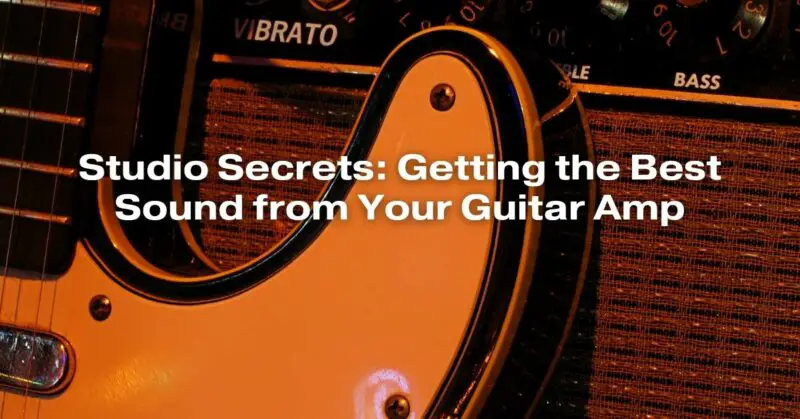In the world of music production, the quest for the perfect tone is never-ending. For guitarists, achieving that ideal sound from their amp is a holy grail. Whether you are a seasoned musician or a budding rockstar, understanding the nuances of your guitar amp and how to harness its full potential in a studio setting can significantly elevate your sound. In this article, we will unravel the studio secrets that can help you get the best sound from your guitar amp.
Understanding Your Gear
Before delving into studio techniques, it’s crucial to understand the gear you’re working with. Different guitar amps have distinct characteristics, ranging from warm tube tones to sharp solid-state sounds. Knowing the ins and outs of your amp, including its wattage, speaker configuration, and built-in effects, is essential. Each element contributes to the overall sound, and being familiar with them can guide your choices in the studio.
Choosing the Right Amp
Not all amps are created equal, and the best amp for studio recording might not be the one you use for live performances. Low-wattage tube amps are often preferred in the studio due to their ability to produce rich, harmonically complex tones at lower volumes. They saturate naturally, creating a warm sound that sits well in a mix. High-wattage amps can also be used but require careful mic placement and possibly an isolation booth to manage volume levels.
Mic Placement
One of the most critical aspects of capturing a great amp sound is mic placement. The placement of microphones in front of the amp’s speaker greatly influences the recorded tone. Experimenting with various mic positions, such as on-axis, off-axis, near the center, or closer to the edge of the speaker cone, can yield dramatically different results.
On-Axis: Placing the microphone directly in front of the speaker cone captures a bright and aggressive tone.
Off-Axis: Positioning the mic slightly off-center or at an angle can mellow out harsh frequencies and produce a smoother sound.
Distance: Moving the mic closer to the speaker produces a more pronounced bass response, while pulling it back captures more room ambiance.
Choosing the Right Microphone
Different microphones have unique tonal characteristics. Dynamic microphones like the Shure SM57 are popular for amp miking due to their durability and ability to handle high sound pressure levels. Condenser microphones, on the other hand, are more sensitive and capture a broader frequency range, making them suitable for capturing nuanced tones. Ribbon microphones, known for their warm and natural sound, are also a favorite choice for recording guitar amps.
Utilizing Room Acoustics
The room in which you record your guitar amp plays a significant role in the final sound. A small, acoustically treated room can reduce unwanted reflections and create a tighter sound. Conversely, recording in a larger room with reflective surfaces can add natural reverb and depth to your tone. Experimenting with different room environments can help you achieve the desired spatial quality in your recordings.
Utilizing Amp Simulators and Plugins
In the digital age, amp simulators and plugins have become powerful tools for shaping guitar tones. These software-based solutions emulate the characteristics of various amps and effects pedals, allowing for endless experimentation. While purists may prefer the analog warmth of a real amp, amp simulators offer convenience and flexibility, making them a valuable asset in modern music production.
Experimentation and Creativity
Ultimately, getting the best sound from your guitar amp in the studio is a creative process. Don’t be afraid to experiment with unconventional mic placements, different amps, or a combination of amp simulators and real amps. Every guitarist and every song is unique, so what works for one track might not work for another. Trust your ears and be open to trying new techniques to discover your signature sound.
In conclusion, getting the best sound from your guitar amp in the studio involves a combination of technical knowledge, creativity, and a good understanding of your equipment. By mastering mic placement, choosing the right microphone, understanding your amp, and utilizing the studio environment to your advantage, you can capture a guitar tone that not only sounds incredible in isolation but also sits perfectly in the mix, making your recordings truly shine. Remember, the studio is your playground – explore, innovate, and most importantly, enjoy the process of sculpting your perfect guitar sound.


